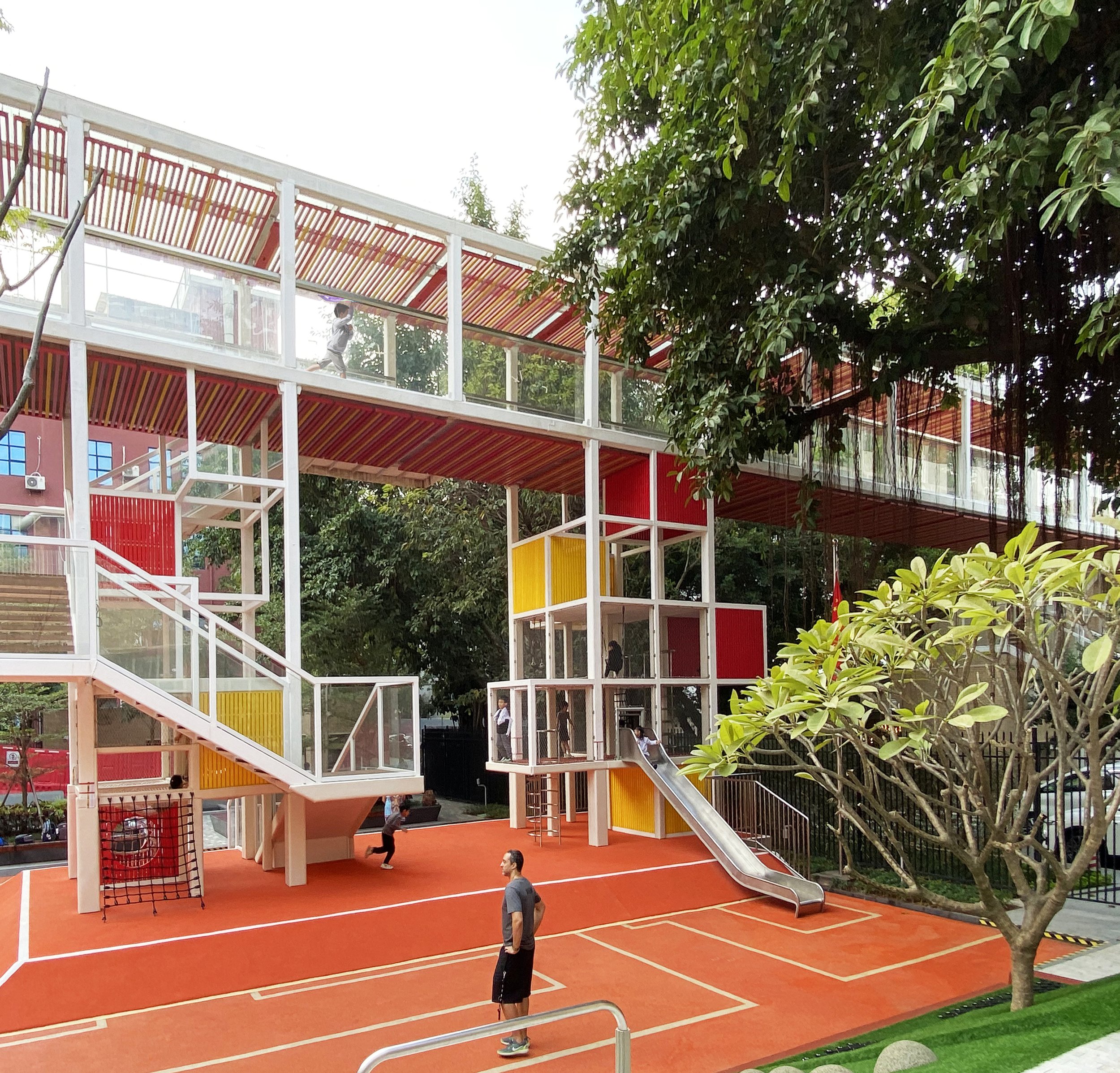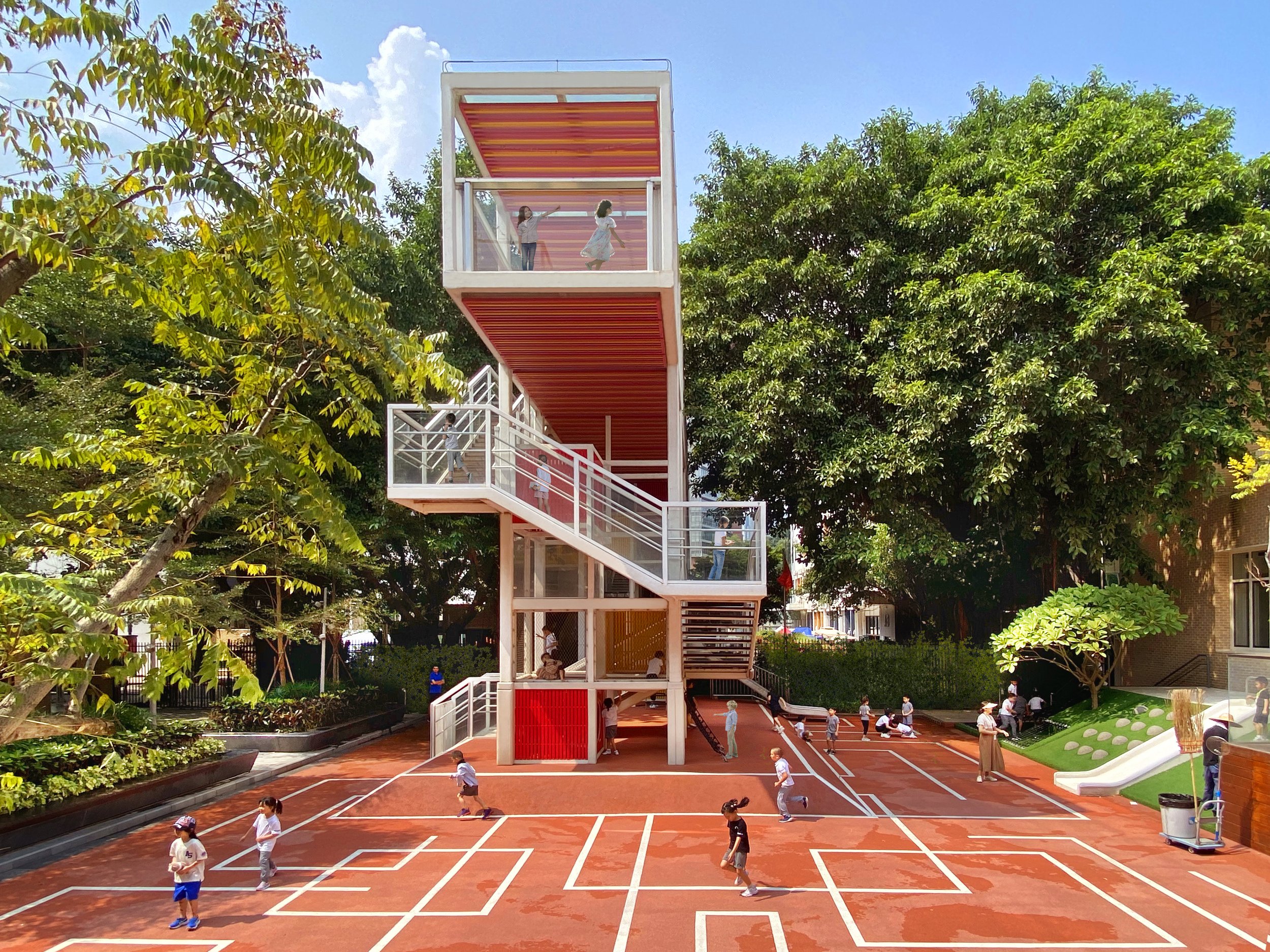Empathy with Nature: How to Leverage Play in Early Learning
June 05, 2025
By Aybars Asci
Play is immersed in all stages of our lives. We play with ideas, we play with things, we play with people. We can actively participate in play, or we can watch other people play. It takes multiple forms; it can be spontaneous or structured. There are pickup games, sporting events, performing arts, role plays, imaginative plays, children’s plays, etc. In our adult lives, play is often associated with pastime recreational activities that are not “work”—we either work or we “play.” During early stages of our lives, on the other hand, it is not that binary. It is more visceral, and in fact, play is how we discover the world. German poet and playwright Friedrich Schiller defines play as a crucial human drive, and he argues that it is only through play that we become human beings in the fullest sense of the word.[1]
Avenues Shenzhen Campus – Roof Terrace before & after
From a human development perspective, there is an authenticity to play. It caters to our curiosity, and the best forms of it can be observed in young children, where life is not yet tethered by any preconceived notions, but a pure landscape of discovery. As child development psychologist Lev Vygotsy points out, for young children, play is a serious game, and when children play, the differentiation between imagination and reality does not exist.[2] Young children have not yet acquired enough data points to constitute what adults assume to be real situations. Children discover the world through play, by using their imagination, like an explorer in a foreign land.
Avenues Shenzhen Campus – Roof playground (after transformation)
In the context of structured play, the discussion on play and architecture, such as sports arenas, is a stale topic, because the design of the physical environment is strictly dictated by the rules of the game just like the game itself. However, playground design can be playful in the sense that the play that takes place here is not structured by predetermined rules and, therefore, creating spaces that encourage imaginative play is possible, and even desired. In the context of human development, a successful architecture of play creates an environment where games are invented, characters imagined, and new narratives emerge.
Avenues Shenzhen Campus – Roof playground (after transformation)
There is tremendous potential for creating environments that will foster empathy in imaginative play. For instance, young children can create new narratives and build new perspectives as they play. Moreover, particularly for early learning, there is a unique opportunity to create empathy with nature through play. As Schiller described, play gives us the power to shift perspectives. This shift in perspective can move us away from a human-centric perspective toward a more ecocentric perspective. Through play we can create empathy with nature, in purposefully designed learning environments for young children.
IMAGE 04 – Avenues Shenzhen Campus – Roof Tensile Canopy
In the Avenues Shenzhen School Campus, we established a dialogue with urban nature. In this adaptive reuse project, located in a dense urban context, we completely renovated and repurposed the existing buildings. One of the central design strategies of the project was to create outdoor learning environments by activating the rooftops into playgrounds. The rooftops are transformed into a biophilic environment that utilizes natural materials and landscaping, covered with a series of light breathable tensile fabric roofs for a comfortable environment for the children. The uplifting lightness of the roofs creates a memorable playspace for an age group that learns through movement.
Avenues Shenzhen, Pedestrian Bridge & Vertical Playgrounds
The Tanglang Mountains surround the Avenues Shenzhen campus, and the largest of the three tensile canopies is carefully organized to frame the long vistas toward the mountains, while creating a shaded and comfortable outdoor learning environment for the students. The catenary curves of the canopy cable structure create a roof profile that counterpoints the silhouette of the mountains. There is an interplay between the lightness of the canopy and the permanence of the mountains. This type of dialogue between the human-made and the natural environment within the urban context is an important part of the design lexicon that we need to develop, especially in spaces for self-initiated play, to encourage the children to develop a language of connections with nature.
Avenues Shenzhen, Pedestrian Bridge & Vertical Playgrounds
At the ground level, the playground for the campus’s Early Learning Center is lined by a row of native banyan trees. Their intricate root and branch structure define the edge of the campus. The engagement with this intricate organism allows for blending the boundaries of the playground and creates opportunities for children to engage with the trees. As a design strategy, the blending of the school playground with the banyan trees play a significant role in situating the school in its unique environment.
Avenues Shenzhen, Pedestrian Bridge & Vertical Playgrounds
We connected the seven former industrial buildings of the campus with a series of bridges. These interconnecting bridges utilize a design strategy analogous to the intricate upside-down spatial growth of the banyan trees. As the bridges negotiate different horizontal levels of the campus, the columns and the beams merge into one another, forming a complex and ambiguous organism. Especially in the playground of the Early Learning Center, where the bridge comes down to meet the ground, the elements of the structure suggest a sense of upside-down growth like the banyan tree, as the spaces within the bridge appear to be suspended. This labyrinthine spatial structure is occupiable at multiple levels, which in effect creates a “space of negotiations” between the horizontal and the vertical axes, or between the context and the school. The key functional element of this space of negotiations is a new typology: the vertical playground.
Avenues Shenzhen, Pedestrian Bridge & Vertical Playgrounds
The vertical playgrounds create an environment for discovery that juxtaposes the playscapes with the banyan trees, allowing children to see this fascinating organism through different spatial frames of reference. “Play” is the critical activator of this spatial construct because it is through play that we can blur the lines between nature and architecture both physically and imaginatively. As children climb up and down the ladders or move down the slides, they see different parts of the trees in their perspectival space. When they walk at the bridge level, they pass through the canopy of the trees, observing the strangling branches growing toward the ground. The architecture of the vertical playgrounds does not try to mimic nature formally. In fact, the choice of materiality and color is designed to differentiate the structure from the trees. However, the structure becomes an armature to encourage the children to experience the nature. Its purposefully choreographed elements are designed to integrate the banyan tree into the children’s innate perceptual space, so that their self-initiated play in these intricate, labyrinthine spaces can begin to construct a new perspective that builds connections with nature.
Avenues Shenzhen, Pedestrian Bridge & Vertical Playgrounds
Reference:
[1] Friedrich Schiller, Essays: Letters on the Aesthetic Education of Man (The Continuum Publishing, 1993).
[2]Lev Semyonovich Vygotsky, Mind in Society: The Development of Higher Psychological Processes (Harvard University Press, 1978), 104.








